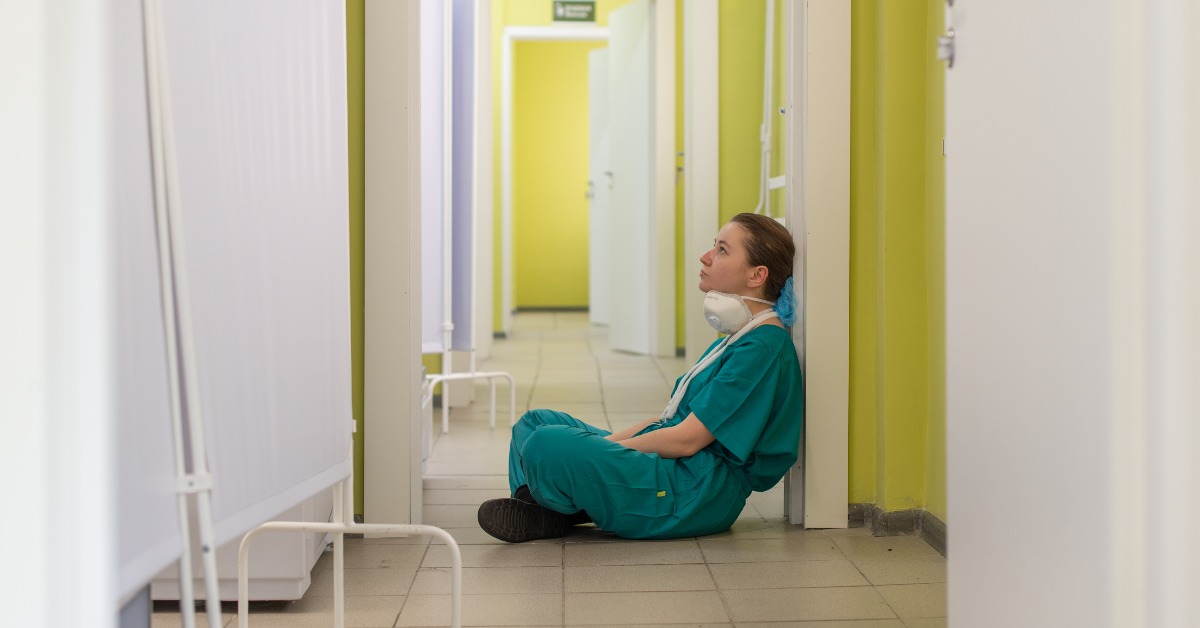Fortunately, the reality wasn’t as dire as it seemed – but it was intimidating, especially as I was too embarrassed to ask for clarifications! In reality, SIM Labs in nursing school play a significant role in testing your knowledge and clinical decision-making skills. Ace them and they will help you avoid the awkwardness of your first day at clinicals.
What Is a SIM lab?
SIM Labs, or nursing simulation labs, are special training sessions in a mock hospital room on your campus.
The specifics will vary depending on your school’s budget and the standard set by your local hospital. You can expect some iterations of the following elements:
Hospital-like beds
This includes the actual hospital bed (the kind you can raise, lower, tilt, or warm up) and all the surrounding furniture: divider screens, a night table, an IV pole, and even a bedpan or commode.
A lifelike mannequin
Each hospital bed needs a hospital patient. In a SIM lab, a special anatomically-correct mannequin will usually play this role. Over the past 10 years, these dummies have grown to be increasingly realistic – but depending on the quality and model your school bought, such realism can fall anywhere between “high-tech cool” and “uncanny valley creepy.”
Many can produce heart and lung sounds and provide electronic feedback for telemetry equipment, Spo2 readers, and heart rate monitors. The following are some other standard features you can expect:
- Lifelike joints, which will bend realistically
- The ability to move “spontaneously” or shake in a seizure-like way
- Soft latex “skin” areas, especially near catheterization or cannulation points
- Some degree of “speaking” that can range from simple pained whimpers to full-on phrases.
Newer models can also cry, blink, and dilate their pupils. The ones at my school didn’t – I’m thankful for that. We did have a “baby mannequin” who could suckle, which was eerie.
Monitoring equipment
Connected to your fake patient, you will find realistic replicas of the same monitoring equipment you should see at a hospital. Most schools nowadays offer a full telemetry setup and a crash cart. If you are lucky, you can also play around with an oxygen tank, an IV pump, or an EKG machine.
Your “patient” and its monitoring equipment will be programmed beforehand or controlled remotely from a nearby room (most likely by one of your lecturers).
Some SIM Lab rooms also have a few cameras to allow lecturers to see how you perform during the simulation. Other times, your lecturer will be behind a one-way mirror or standing in a corner.
So what is the purpose of all this fancy equipment? As its name indicates, it will be to simulate your reactions to a realistic clinical scenario.
SIM labs let your lecturers see how you apply what you’ve learned in a hands-on environment, how quickly you react, and whether you truly understood the rationale behind all those multiple choice questions you answered in class.
What’s the Difference Between a SIM Lab and a Skills Lab?
SIM labs and skill labs are both unique to health education – plus, they sound similar enough to be commonly confused. So what is the real difference between them?
Skills laboratory sessions allow you to practice a specific manual skill, which can be something as simple as a bed bath or a more complex procedure such as an IV placement. Either way, you’ll have one task and one goal: to train your muscle memory and dexterity until you can perform it without glancing at your pocket checklist.
During a skills lab, you will be solely focused on that skill. At most schools, you won’t even be working with the full mannequin – often, they will just give you an arm, leg, or chest piece so you can practice to your heart’s content.
Many classes also include an additional skills check or exam.
Meanwhile, SIM lab sessions are scenario-based. You will have a complete patient with a medical history and several health complaints. You will have to treat your fake patient like a real human. This includes drafting a care plan, asking for consent, and performing a series of procedures on the go. Depending on the course and its objectives, your fake patient can have a seizure, develop further problems during the test, or even crash.
Becoming a nurse has never been easier.
Set yourself up for success with Lecturio
Why the SIM Lab Matters
At first glance, the SIM lab experience can feel like a weird mind game: let’s put these students in a very difficult situation, and subject them to The Hunger Games, Hospital Edition. In reality, the SIM lab helps you bridge the distance between theoretical knowledge and hands-on care.
Before we had access to realistic, electronic mannequins, many schools used human volunteers or paid actors to perform simulations. These were very useful for practicing your bedside manner or performing a head-to-toe assessment. Still, they couldn’t include actual procedures – few people are willing to let themselves be poked with an IV cannula or a defibrillator by a student, even for money.
So what can a SIM lab provide now? Beyond your lecturer’s laundry list of objectives, I found them tremendously helpful with three things:
1. A chance at low-stakes realism
Yes, I’ve had my plastic patients die on me. Several times, actually. It was awful and embarrassing, and it meant that I had made the wrong decision during the simulation. Now, I’m so glad it happened!
At the end of the day, nobody really died. My lecturer hit the reset button, and good old Charlie Brown was ready to go again.
She then pointed out exactly what we did wrong and why it was the wrong choice, and we all walked out a little wiser about the small details that rookies are prone to miss.
If this had happened during clinicals, I probably would’ve stepped back and let my RN make all the decisions. I would’ve followed orders fine, and it would’ve made sense afterward, but I wouldn’t have understood the gravitas of my possible mistake.
2. Flexing your critical thinking muscles
Nurses now have a much broader scope of practice and can make many independent decisions compared to just 15 years ago. Nursing classes can prepare you for this, but only up to a certain point. All those care plans we’re constantly following teach us how to reason through someone’s health problems and spot the interventions that will give us the best possible results.
However, it’s one thing to do this after class, in front of your computer, with your Pathophysiology manual open in another tab. It’s very different to remember all this information – the way organs work, the drug interactions, the contraindications – when you are at the hospital, faced with a patient who is deteriorating rapidly or not cooperating.
The ability to recall everything quickly, or to make a confident call, is kind of like a muscle. You will need to exercise, test, and push it toward its next boundary.
3. Finding your feet and flow
Here’s a weird aspect of hospital work: When things are happening rapidly around you, it’s hard to find the right place to stand. You want to help and be close to the action, but you also don’t want to be in the way of others. You need to set up a tray without making a mess for others and find a place for your elbows that is not at your colleague’s nose.
During a SIM lab, you’ll work with a group of fellow students, each with a specific role. You will all be expected to work as a unit and to ensure that your actions “flow.” The more you do it, the ability to place yourself where you’re needed will become second nature.
What Can You Expect from the SIM Lab?
No matter which course you’re taking, almost any SIM lab will consist of three main stages (yay, standardization!)
Simulations are almost always conducted in groups. After all, a significant section of the learning objectives deals with effective teamwork. These groups usually consist of about four students – for some advanced classes, you can see groups of up to six. More people don’t make the exercise easier: anything more than 5 tends to feel crowded and will lose realism.
After forming the lab groups, your lecturer will provide a pre-briefing or scenario presentation. Here, your teacher will give you some background info on the patient, their past history, and the type of unit or floor you’ll be simulating. Often, this info will be provided using the same format and language as a shift handover for added realism.
Sometimes, they will also establish the “rules of the game” and give you a quick overview of what they’ll evaluate or how long the exercise will last.
Then, you’ll play out your scene. The key to success is acting as if your plastic patient were a real one. Delve into your roleplaying soul, greet them, and explain everything just like you would a patient. Make sure to read the nursing or medical “notes,” which often include extra lab results or other valuable information.
After you complete the scenario, you’ll have a final debrief or review. Your instructor will point out any critical information you might have missed or quiz you about specific choices you made during the scenario. If your SIM lab is equipped with cameras, the instructor may review parts of the recording with you.
Nervous About Your First SIM lab? Four Tips for the Best Start
If you have an upcoming SIM lab session, expensive equipment, an unfamiliar environment, and stage fright can all increase your anxiety. So how can you prevent this?
Here are five tips to help you prepare.
1. Review your checklists and procedures
Before the lab, make sure you review the protocols for any major skills that could be necessary. Although instructors rarely give too many hints beforehand, you can usually gauge what type of scenario they’ll be interested in running.
If you can, practice any manual skills at home while reciting the steps or the safety precautions you’re taking as you do them. This will keep you from any critical oversights in front of your lecturer.
2. Remember your nursing process and rationales
This is the time to observe your care plans in action! Most SIM lab sessions won’t give you enough time to write an entire care plan or reformulate all the information provided. However, your actions should still be guided by the same process.
Read your nursing “notes,” ask questions and examine the patient, and start separating the types of data you see. Document your monitor’s readings on the chart. Ask your lab mates for a diagnosis, and work out a plan as you did in class.
If your patient starts crashing or crying, announce what you will do out loud, followed by the reason. Your lab mates might be confused or have noticed something you missed, but they can’t read your mind.
3. Ask about the office hours
Most SIM Labs have designated office hours during which any group of students can come and run a practice simulation independently. If these are not posted publicly, ask your instructors or the lab admins about them.
If you are working with a new group, book the lab before your formal lab session and have a practice run. Even if you work with a different scenario, it will be easier if you are clear on your roles and know each other better.
4. Treat your “patient” as a person
Yes, they’re made of (mostly) plastic, but lecturers and instructors expect you to act as if this were a real person. Engaging too much will be better than losing points for engaging too little!
Greet your doll and explain the procedure to them. Ask for consent. If your setup includes privacy screens between beds, make sure you close them before you start – or just ask out loud if they would like you to close them!
High-tech simulation labs are a relatively new trend in nursing education – but some degree of roleplay has always been present. Prepare for them, and embrace the opportunity for safe learning!





